Content
It is especially important for hypertensive and hypotensive patients to know whether honeysuckle lowers or increases blood pressure. Incorrect use of berries in food is fraught with deterioration in well-being. Therefore, it is necessary to take into account the recommendations of specialists and observe the dosage.
How does honeysuckle affect blood pressure?
The berry has the same effect on blood pressure as antihypertensive drugs. It dilates the walls of blood vessels by blocking the synthesis of prostaglandins. On this basis, the level of blood pressure decreases. In addition, the product helps to remove excess fluid from the body, which has a normalizing effect on blood pressure. Therefore, hypotonic people should refrain from eating berries, as it can worsen their well-being.
For hypertensive patients, honeysuckle helps to cope with headaches and restore efficiency. The berry has a mild effect on the body, which reduces the risk of side symptoms. At the same time, the product prevents cardiovascular disorders and excludes the development of a heart attack.
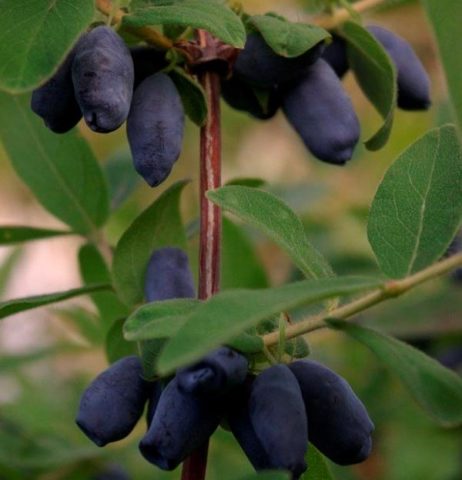
The berry has a sour taste with a slight bitterness.
Useful properties of honeysuckle under pressure
Honeysuckle helps with high blood pressure due to its rich composition. The desired effect is achieved by strengthening the vascular walls and improving the blood circulation process. This allows it to be used not only for hypertension, but also for the treatment of atherosclerosis and iron deficiency anemia. The beneficial properties of honeysuckle include:
- replenishment of the supply of iron in the blood;
- normalization of blood circulation;
- increasing the elasticity of the vascular walls;
- regulation of hemoglobin levels.
Eating honeysuckle berries from pressure helps in a matter of hours. A small portion of the fruit is enough for this. They can be eaten both in pure form and as an addition to yogurt, jelly base or berry jelly. The effectiveness of the product will change insignificantly from this.
Contraindications to pressure honeysuckle
The natural origin of honeysuckle does not exclude the presence of contraindications. Before taking it for food, you should make sure that there are no unwanted reactions. Absolute contraindications include:
- individual intolerance;
- period of bearing the child;
- increased acidity of the stomach;
- breast-feeding;
- low blood pressure.
The use of honeysuckle under reduced pressure provokes a decrease in performance and general weakness. Occipital pain and shortness of breath may also appear. In some cases, there is nausea and vomiting. If there is an individual intolerance, then the use of berries will contribute to the appearance of skin rashes. Exceeding the dosage leads to indigestion. In rare cases, a hypotonic crisis develops.
Folk recipes for pressure honeysuckle
In alternative medicine, honeysuckle is considered the most powerful ingredient in antihypertensive drugs. The berry received such distribution due to its rich composition. The presence of a large amount of ascorbic acid strengthens the walls of blood vessels, and vitamin B ensures the normalization of metabolism.The antioxidant properties of the product help cleanse liver cells. Each recipe using a healthy berry has its own purpose and dosage regimen.
Leaf decoction
With pressure, it is often prescribed to take honeysuckle broth. It relieves headaches and tones the body.
Components:
- 1 tbsp. hot water;
- 30 g of honeysuckle leaves.
Cooking process:
- The leaves are poured with water and placed in a water bath.
- The broth is cooked for 10 minutes.
- After removing from heat, cover the container with a lid. The broth is infused for two hours.
- Filter the liquid before use.
- The broth is taken in 1 tbsp. l. four times a day before meals.
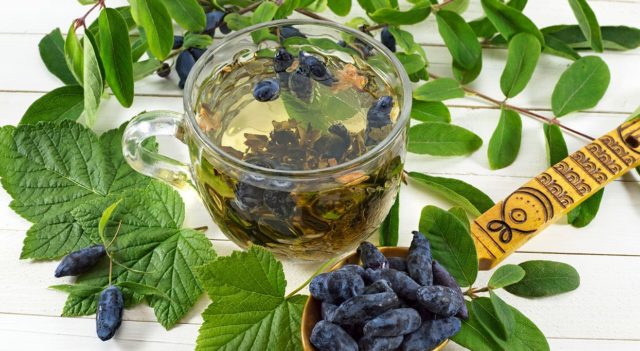
Due to the content of glycosides, you should consult your doctor before taking the decoction.
Berry tincture
Before taking alcoholic tincture, you should make sure that there are no contraindications. The medicinal drink is prohibited for people suffering from alcohol addiction. In addition, it should not be given to children under the age of five. Tincture can aggravate the course of gastric ulcer and gastritis. Therefore, in case of chronic pathologies of the digestive system, it is better to refuse it. It is equally important to observe the dosage, since its violation can lead to unforeseen reactions of the body.
Ingredients:
- 500 ml of alcohol;
- 50 g dried honeysuckle.
Recipe:
- The berries are poured into a glass bottle and poured over with alcohol.
- The container must be corked and put in a dark place for a week.
- Shake the bottle every 2-3 days.
- The finished tincture is filtered.
- It should be taken in 1 tbsp. l. twice a day. Reception is carried out before meals.
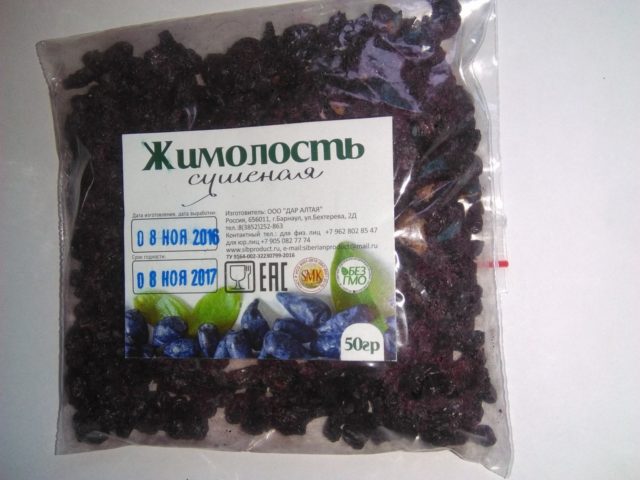
In dried form, the berry retains its properties throughout the year.
Honeysuckle decoction
Components:
- 400 ml boiling water;
- 1 tbsp. berries.
Cooking process:
- The main ingredient is placed in a saucepan and poured over with boiling water.
- Cook over low heat until boiling.
- The cooled broth is taken in 50 ml five times a day.
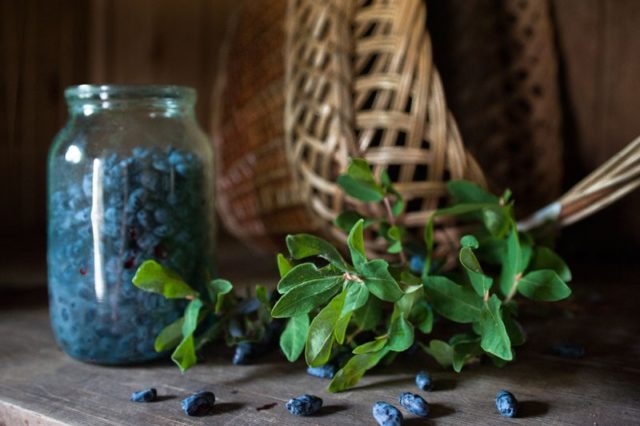
The broth has an excellent diuretic effect
Infusion of honeysuckle on water
A water-based infusion is relevant in cases where it is undesirable to take alcohol-containing products. It has a more gentle effect on the body, but does not differ from other therapeutic agents in its effectiveness. This infusion is often given to children.
Components:
- 200 ml of cold water;
- 50 g honeysuckle.
Cooking process:
- The berry is placed in a deep bowl and crushed with a crush until the juice is released.
- The resulting mixture is poured with water and refrigerated overnight.
- The remedy is taken orally the next day.
Reception is carried out every three hours. A single dosage is calculated so that no more than 100 ml is obtained per day.
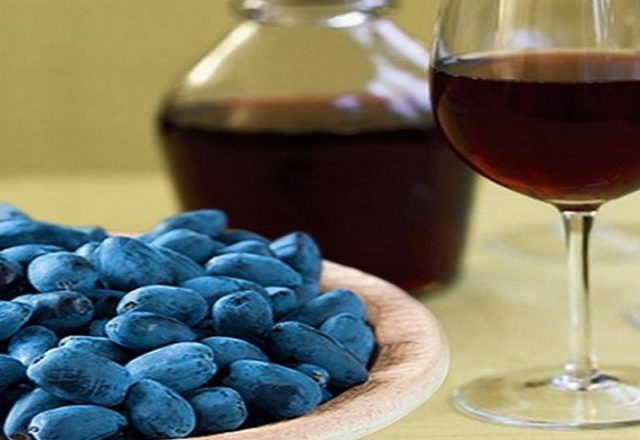
Honeysuckle infusion has a tart taste
Honeysuckle bark decoction
The bark of a bush contains no less nutrients than its fruits. It perfectly relieves swelling and eliminates the headache characteristic of high blood pressure.
Ingredients:
- 500 ml boiling water;
- 100 g of bark of a bush.
Cooking steps:
- The bark is crushed in any way possible to a powdery state.
- The resulting raw material is poured with water and put on fire.
- You need to cook it for half an hour.
- After removing from the heat, the broth is filtered and removed to the side.
- It should be taken after 30 minutes of infusion.
- Reception is carried out in 20 ml four times a day.

A decoction of the bark can be used to gargle
Rules for the use of honeysuckle from pressure
Honeysuckle from pressure is used, taking into account the properties and contraindications. To achieve the desired therapeutic effect, you should take a honeysuckle-based remedy for a long time. But improvements come after the first application. The average duration of admission ranges from 7 to 14 days. The daily dose of tincture or decoction is divided into 2-5 receptions.
Conclusion
You need to know if honeysuckle lowers or increases blood pressure, at least in order not to face its side effects. When used correctly, the berry is extremely beneficial to health. It has a tonic effect on the body and lowers blood pressure.








